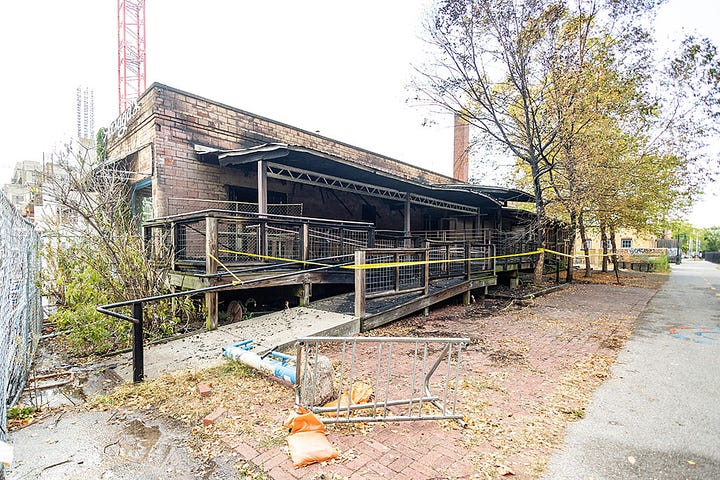Greetings from Diet Austin and a Happy New Year!
WHEN IN ROME
New Year’s has come and gone. I spent the holiday in full-fat, unprocessed Austin, and I returned home apparently a new me. The first days of the year were spent studying *Ancient* Roman history (gasp!) To calm your panic that I have gone up and down I-35 only to throw away my Italian Renaissance Brand to the She-Wolf of Rome’s early years of naught, I assure you that this is just a phase! In my constant search for metaphors through which to elucidate and obscure my own personal narrative, I yearly cling to mine (and western history’s) old faithful for new years symbolism: Ianus.
Ianus or in anglicized Latin, Janus, is the Roman god for which January was named once the 12-month calendar was adopted by Julius and fortified by Pope Gregory. Janus has been my favorite god of the Roman Pantheon since 2019 (the definitive ranking of Clio Rom’s pantheon drops soon), and frankly he doesn’t get enough attention. Step aside Jupiter! Venus, don’t make it about yourself for one f*cking month! Our guy is known most for his physical appearance: a man with two faces (not to be confused with Kevin McCarthy) looking in opposite directions– an old man looking back, a young man looking forward. The Etruscans had a similar looking god, Culsans. Happy Culsanary, if you will!!
The Romans heralded Janus–and his regional doppelgängers–for his presiding over doors and gates, serving as the patron deity of thresholds and transitions. Some classicists and archeologists suspect the first arches for which Ancient Rome is famed as being dedicated to Janus. Roman soldiers marched out of these ceremonial gateways, often placed on the peripheries of the central city, on their way to conquest. The ritual passing through an arch acknowledged the act of leaving the city, honored the transition that occurs in the transgressing of a threshold, and anticipated the expected triumphs after exiting the space.




Even if the change from one year to another was arbitrarily decided by past Caesars and popes, January retains the qualities of its namesake by providing this space for reflection on the past which informs our expectations of the future. It the proverbial ceremonial arch of our western calendar and deserves the same ritual-like reverence for its liminal power with which the Romans gave Janus beyond the seven days Larry David allows us to wish each other “Happy New Years”.
This year, I aimed to have the head of Janus. One set of eyes looking toward the upcoming and another looking back with acute awareness of the path that has led us to this point in time and place. As cult-followers of Janus, we at Diet Austin rested in the threshold of January’s gate to take stake in why this particular month, following this last particular year, and leading to this particular year, seems so significant. Something about Northwest Arkansas in 2022 felt different in every facet of its landscape. With years of additions to municipal places across the region, expansion of cultural infrastructure, amplification of entrepreneurship, and cultivation of a new creative class, Northwest Arkansas has of course faced physical transition. Yet we have turned a corner that surpasses visual transformation. There is a palpable vibe shift which only Chicken Joe from Surf’s Up could articulate.
THE RUNDOWN
In 2022, The Walton brothers’ venture capital Runway Group introduced the FORMAT Festival and the CANOO car, a success and a flop respectively. They also hosted now-former Governor Hutchinson's PAC with SHS and Betsy DeVos for the “America Leads Summit” in the halls of an art institution that proudly boasts “You Belong Here.” Bentonville developers opened their art-filled, bikeable Ledger Building in which only a bike shop and café are open to the public. Crystal Bridges reduced their budget by 10%, and while remaining employees largely seem to be having a Bad Time, chairperson Olivia Walton hosted a $5K+-per-ticket gala for her bi-coastal fashion friends to party, take pics, and proclaim the region as their “beloved Midwest” to their Instagram followers.
Tom Walton’s passion project is to make Oz a hub for tourist-driven outdoor recreation. In December, he brandished his plans to leverage our “free flowing rivers” and other natural features for the state’s (and his) economic growth under the guise of expanding accessibility. We aren’t in Oz and we never will be, Toto!!!! This continues a fifty-year-long fight between entrepreneurs, conservationists, and rural Ozark inhabitants, solidifying the sad theme throughout the history of our beloved greater White River Basin: dammed if they do, damned if they don’t.
Moving south down the interstate, the Hunt-funded MIXD gallery opened up in the Rogers neighborhood of Little DFW under the admirable crusade of teaching people to value, invest, and live with art. One can finally get a Torchy’s Taco, play Top Golf, and acquire an over-sized and under-theorized abstract painting in one easy trip!!! In Springdale, Tyson announced the closing of their satellite headquarters across the country with a push to move their middle-management operations back to main-street Emma Avenue. Meanwhile, their Marshallese and LatinX-dominated workforce struggle to build equity due to lack of fair wages and affordable housing throughout the company town. Their family foundation, champions of place-making, opened the “art-themed” basketball court which lays over the iconic Dickson Street Theater, a former and beloved queer-space (where first I danced to Gaga’s Poker Face in 2008) razed for the sake of making a new place (now with merch!).


Fayetteville’s sacred place of yesteryear, Arsaga’s Depot, burned to the backdrop of a cement parking garage while Lioneld Jordan fiddled and cried funky at the Farmer’s Market. Steuart Walton (proudly and openly NOT a razorback) wrote an op-ed in the Democrat-Gazette promoting a Utah-based pro-tech chancellor candidate, but the University of Arkansas Board of Trustees thankfully unanimously selected the candidate whose past syllabi included recently-banned critical race theory. Professors and students of the newly minted Walton-endowed School of Art moved into their Windgate-funded, Lego-inspired white and glass building, leaving all in a tussle of who this space actually belongs to. The (unhoused) art history department is now accepting applications for an Art of the Americas master’s program in partnership with Crystal Bridges. Their marketing challenges students to “re-imagine” what art history is by focusing on the Americas… as if the long arc of the art historical canon hasn't pointed westward since its inception.
Northwest Arkansas, in a totally un-Janusian move, is publicly and privately looking towards the future while remaining blind to existing problems, letting them fester unsolved in perpetuity. Government leaders look to establish Arkansas as a hub for space travel, Alice Walton seeks to open a holistic (and private) health institute to transform healthcare as we know it, and the towns amongst the I-49 corridor are rapidly changing their identities towards something that is unique enough to be quirky but restrained enough to be inoffensive towards progressive transplants and conservative locals alike. These changes are all in the spirit of a promising (read: promised) future, handed down to us by the not-so-invisible hands of the powers that be.
THE PROJECT
We initiated the Diet Austin project in January 2023 (more or less) as Northwest Arkansas has become a playground for non-natives and generational heirs who were quick to call the region a blank (to them) canvas while ignoring the imprimatura left by generations of Arkansans before them. This new foundation (surely designed by Modus or Marlin–there are no other architects in NWA, apparently) sustains expansion and growth for everyone except those who have been here since the salad days of the Jose’s smoking section, Dan Coody, and Brenda’s Bigger Burger (RIP).
The Diet Austin project seeks to explore the snake’s nest of this rapidly and artificially evolving region. Northwest Arkansas is not a tabula rossa and with each addition, edit, and development comes erasure of past histories, cultures, and communities. This region is deserving of progress that does not displace.
We ask you to question the promise of refashioning the region and what it might mean if the mistaken-for-benevolent powers deliver on their vision of cultural and technological progress, making NWA the next Austin. At what cost? At whose?
With my Janus head, I try to make sense of what’s happening. Diet Austiners, we are wise to heed the sloppily scrawled words of artist-turned-Gucci-darling Coco Capitán: “What are we going to do with all this future?” and, more importantly, “What is all this future going to do with us?”









This really summed up a lot of the development I've been seeing around the area and all the anxiety I've been having with it. Thank you for sharing!